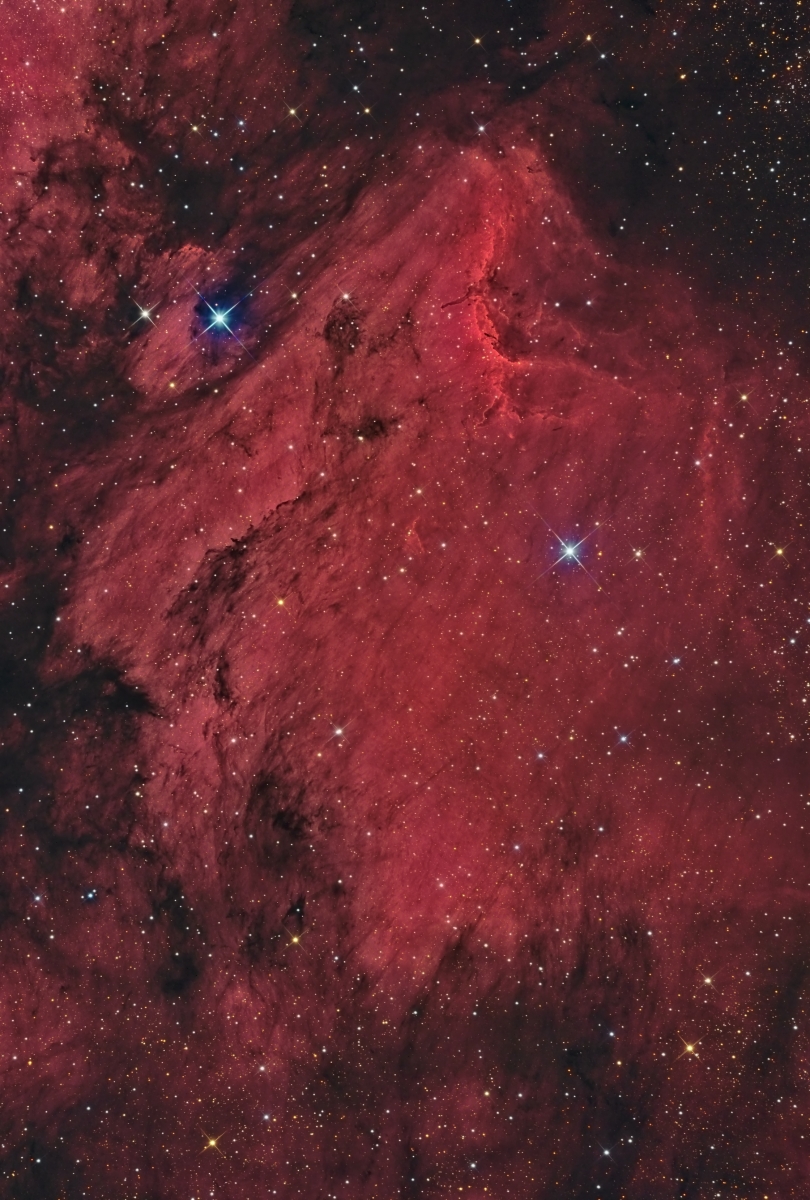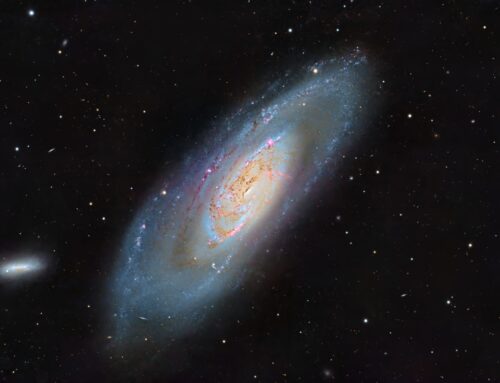IC5070 and IC5067, The Pelican Nebula
Click image for full size version
December 24, 2014
I think this ought to be called the Pterodactyl Nebula, but it isn’t. It is called the Pelican Nebula. It lies next to the North American Nebula near the bright star Deneb, in Cygnus. Deneb is easy to find high in the eastern sky in the evening during mid to late summer. It is one of the stars of the “Summer Triangle” (you can look up the summer triangle on the internet — it’s easy to find with the naked eye, and a good way to start learning the sky). A couple of people have told me that they see an elephant if they turn the image 90 degrees counterclockwise. The pterodactyl’s crown becomes the elephant’s trunk! What do you see?
The Pelican is made up of two objects – IC5067 and IC5070 and is about 1,800 light years distant. The bright ridge on the crown shows a couple of dark fingers associated with Herbig-Haro object 555. Herbig-Harrow objects are associated with newly-born stars.
This data for this image were acquired in August, 2012.
Tekkies:
SBIG STL-11000M camera, Baader LRGB filters, 10″ f/3.6 ASA astrograph, MI-250 mount. Guided with STL-11000’s internal guider. Focusing with FocusMax. Acquistion, guiding, calibration, registration and integration all done using Maxim-DL. All processing in PixInsight. Shot from my SkyShed in Guelph, Ontario. No moon. Below average transparency and average seeing.
5x10m R, 6x10mG, 6x10m B and 4x20m Ha (total 4hr 10m).
HaRGB:
Ha, R, G and B masters were cropped to remove edge artifacts from stacking. The R, G and B channels were combined to make an RGB image. Ha and RGB were processed with DBE, combined with the NB-RGB script, and Colour Calibration was applied. HistogramTransformation was applied, followed by TGVDenoise and another HistogramTransformation to reset the black point.
Synthetic Luminance:
Creation and cleanup: The R,G,B and Ha masters were combined using the ImageIntegration tool (average, additive with scaling, noise evaluation, iterative K-sigma / biweight midvariance, no pixel rejection). DBE was applied to neutralize the background.
Deconvolution: A star mask was made to use as a local deringing support. A copy of the image was stretched to use as a range mask. Deconvolution was applied (40 iterations, regularized Richardson-Lucy, external PSF made using DynamicPSF tool with about 30 stars).
Stretching: HistogramTransformation was applied.
High Dynamic Range: HDRMultiscaleTransform was applied at 6- and 4-pixel scales with a mask to protect bright stars.
Additional Processing: TGV Denoise was applied and another HistogramTransformation to reset the black point.The Curves tool was used to approximately match the brightness of the HaRGB image’s luminance channel (visual approximation).
Combining SynthL with HaRGB:
The luminance channel of the HaRGB image was adjusted as follows:
1. Extract luminance from the HaRGB image.
2. Apply LinearFit using the SynthL channel as a reference.
3. Use ChannelCombination in the Lab mode to replace the luminance of the HaRGB with the fitted luminance from step 2.
Then LRGBCombine was then used to make a SynthLHaRGB image.
Final Processing
The DarkStructureEnhance script was applied (scale 8, 1 iteration, 0.1 strength). UnsharpMask was used to sharpen the brighter areas of the nebula. Colour saturation and curves were adjusted slightly.
Image scale is about 2.2 arcsec per pixel for this camera / telescope combination.







Leave A Comment